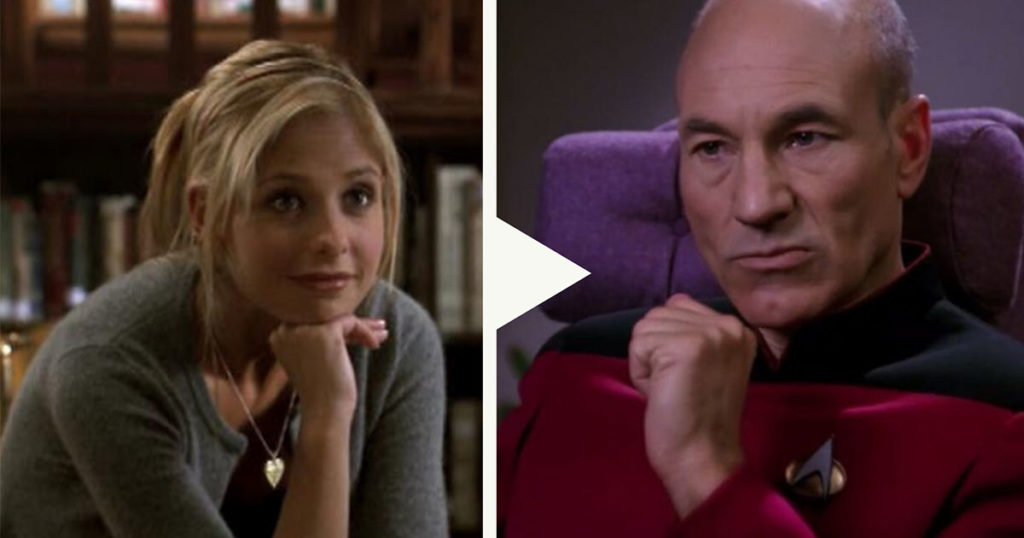
“I’m not a trekker,” Joss Whedon told Rolling Stone in 2009, and I believed him. He even called his sci-fi series Firefly the “anti-Star Trek.” But despite his words, I’ve come to believe Whedon is more of a Star Trek fan than he’ll admit.
I grew up watching TNG—the only thing my parents and I agreed on—but never considered myself a superfan. I did, however, establish my Buffy the Vampire Slayer superfandom early on. By the time I was 30, I had probably watched the entire series at least four times. Then, a few years ago, I decided it was time to revisit TNG for a proper adult viewing and was blown away by discovering just how many plotlines in Buffy episodes seem to directly parallel those of TNG.
Whether paying direct homage or simply by coincidence, the TNG-inspired plotlines demonstrate how each cultural work stands on the shoulders of all those that came before it. Had it not been for the utopia-seeking Enterprise crew, we might not have ever had plucky feminist demon fighters. Whether or not Whedon stans Trek, these are the episodes that turned this Buffy-loving fan into a die-hard Trekkie .
1. TNG: Conspiracy vs. Buffy: Bad Eggs (Season 2, Episode 12)
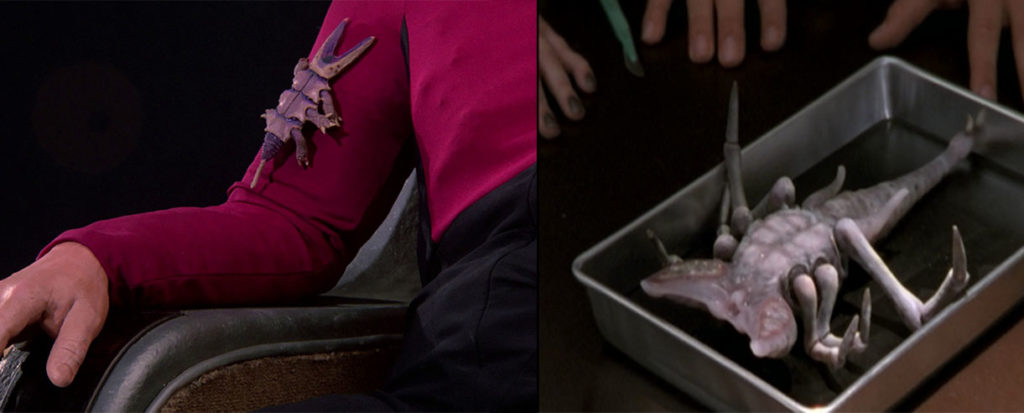
Mind controlling parasites look the same in space and in Sunnydale
Premise: creepy crawly creatures take over people’s brains and turn them evil
This was the first pairing that struck me as similar, and fans on internet forums have noted the similarities as well. In both, insect-like creatures invade human hosts in service to a “mother” parasite. Not only do each show’s creatures look alike (six legs, pincers up front, tail in the back), they even attach to their victims in similar fashion, burrowing into their necks.
2. TNG: Conundrum (Season 5, Episode 14) vs. Buffy: Tabula Rasa (Season 6, Episode 8)
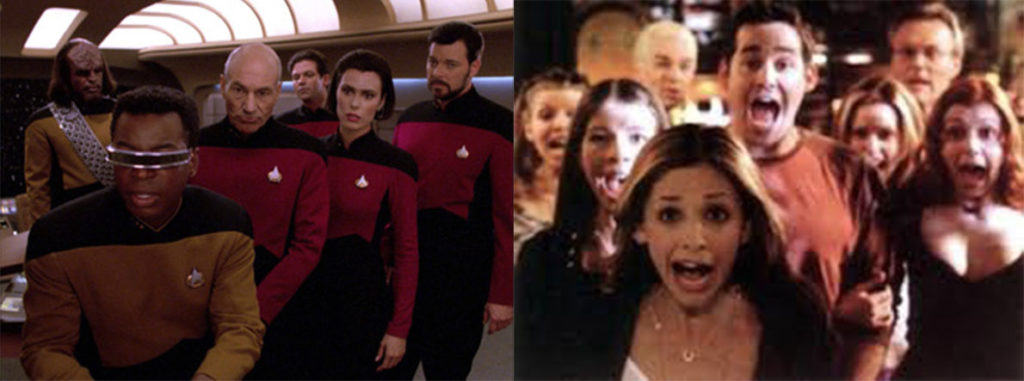
The crew is confused; the Scoobies are terrified
Premise: Group amnesia
The Enterprise crew awakens after being scanned by an alien ship to discover they have no idea who they are. They have, however, retained their unique knowledge and skill sets. In Sunnydale, the gang wakes up to the same situation. Buffy doesn’t know her name, but she still knows how to fight. Hijinks ensue all around, particularly romantic ones. The main difference lies in what causes the amnesia. For the TNG crew, an outsider hijacks their memories. The Scoobies’ was caused by one of their own: Willow casting a spell.
3. TNG: Frame of Mind (Season 6, Episode 21) vs. Buffy: Normal Again (Season 6, Episode 17)
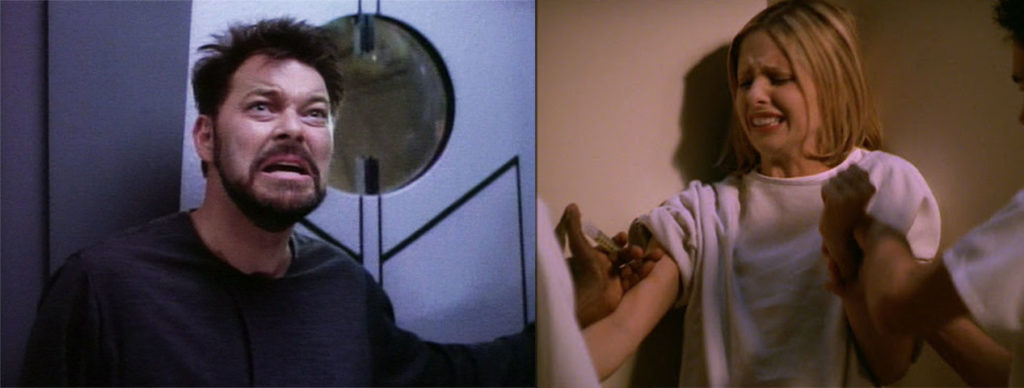
Mental hospital anguish
Premise: None of this is real—you’re just crazy
One of the series’ most controversial episodes, Normal Again finds Buffy shifting between two worlds: one where her friends and monsters she’s battled are real, and one where doctors in a mental health facility try to convince her that those same friends and monsters are actually figments of her imagination. It’s a powerful episode, and it’s also a plot we’ve seen before on TNG, when Riker is held captive during a reconnaissance mission, and his captors act as doctors to make him believe that his experiences aboard The Enterprise were all in his mind.
4. TNG: Second Chances (Season 6, Episode 24) vs. Buffy: The Replacement (Season 5, Episode 3)
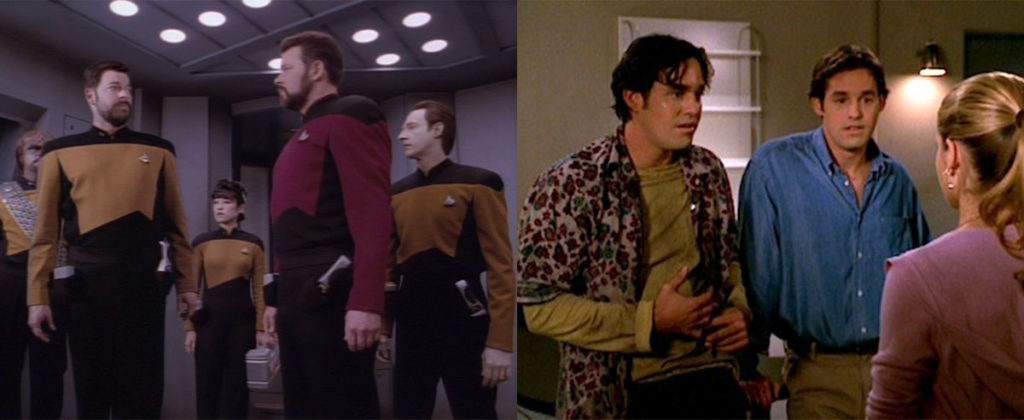
Double the Rikers; double the Xanders
Premise: Double trouble!
What happens when a character gets split into two versions of himself? In TNG, you end up with one Riker that’s a focused career man, and one that’s been pining away for his long lost love with Troi. In Buffy, one Xander gets all the “good qualities” (charm, confidence, etc.) and one constantly looks disheveled. Spoiler alert: The two Rikers and two Xanders aren’t all that different from each other after all!
5. TNG: Eye of the Beholder (Season 7, Episode 18) vs. Buffy: I Only Have Eyes for You
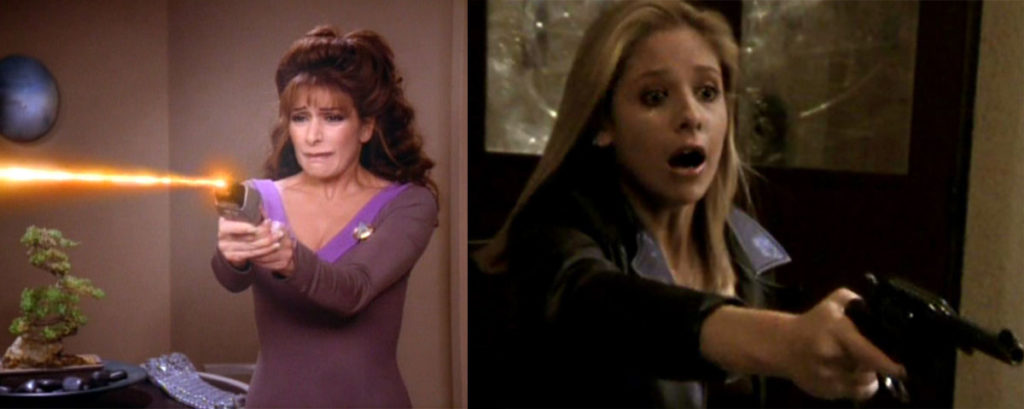
Troi shoots Worf; Buffy shoots Angel
Premise: A past love affair gone bad plays out again and again
Bear with me—this plot’s a bit complicated. In both episodes, the spirit left behind by a man whose love affair turned tragic inhabits the minds of key female characters. When Troi investigates a crew member’s suicide, she becomes entranced by the telepathic memory of Lt. Pierce, who killed his lover and then killed himself. Seeing through his eyes, she seems to live out his memories, killing Worf then attempting to kill herself. In the Buffyverse, the ghost of a young man who—that’s right—killed his lover then himself, causes Buffy to attempt to act out the same events with her lover, Angel. Both are ultimately saved by the lovers they thought they murdered.
6. TNG: The Game (Season 5, Episode 6) vs. Buffy: Band Candy (Season 3, Episode 6)
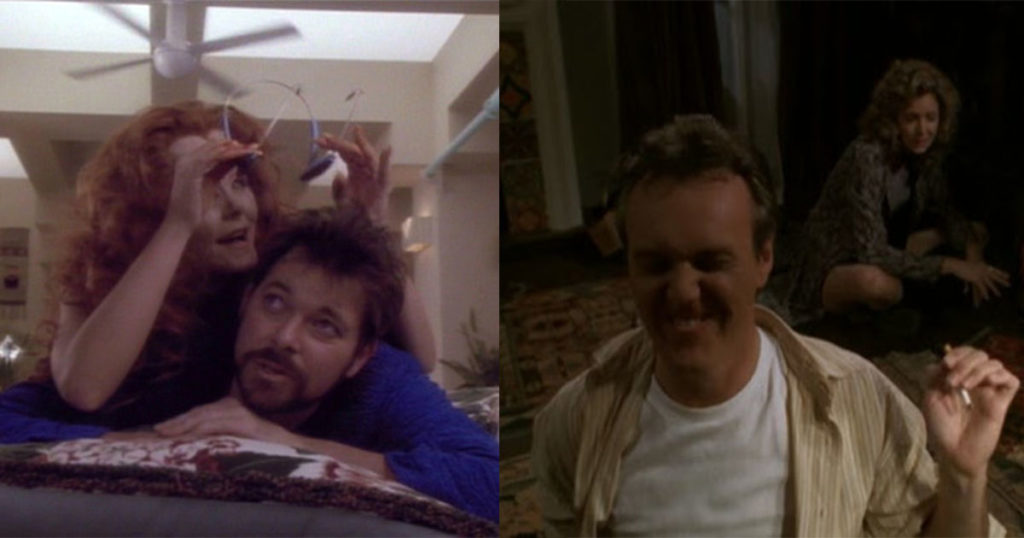
6. Riker gets hooked on a game; Giles gets high on candy
Premise: What if all the responsible adults got hooked on something childish, distracting them from the bad guys running amok?
In space, a Ktarian woman introduces the Enterprise crew to a video game they can’t stop playing. In Sunnydale, warlock Ethan Rayne distributes mind-altering candy, causing adults to act like teenagers. The vehicles for delivery are different, but the effect is the same: adults are rendered useless so villains can exploit the situation. In both cases, it’s the younger generation (Welsey Crusher/Buffy and the Scoobies) that steps in to save the day.
7. TNG: Cause and Effect (Season 5, Episode 18) vs. Buffy: Life Serial (Season 6, Episode 5)
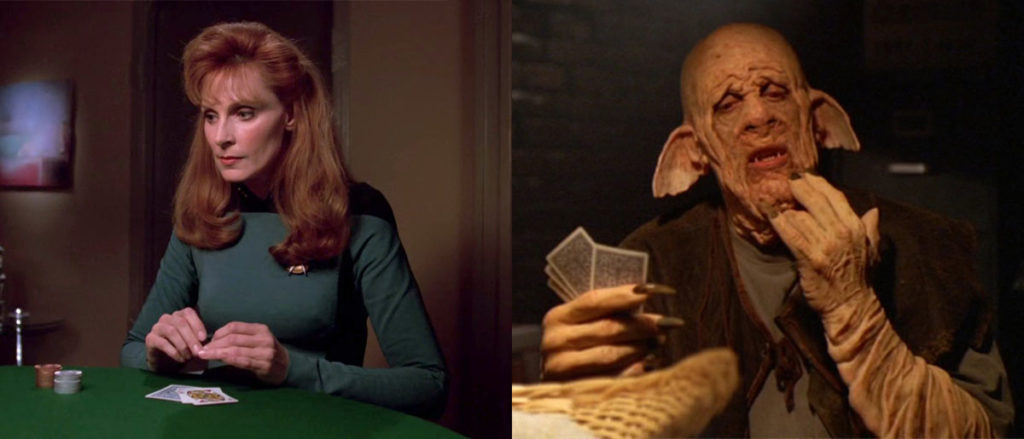
The crew plays poker, and so do the Scoobies
Premise: How do we get out of this time loop?
One of TNG’s most iconic episodes, “Cause and Effect” sees the Enterprise repeatedly exploding, as the crew tries to learn how to stop it. In Sunnydale, a trio of nerds test Buffy by setting a series of puzzles for her to solve, including a time loop where Buffy attempts to sell a mummy hand to a Magic Box patron over and over again. The Buffyverse drops a self-aware reference though, as Andrew says “I just hope she solves it faster than Data did on the episode of TNG where the Enterprise kept blowing up.” Bonus points: later on, Buffy accompanies Spike to a poker game, a subtle nod to the Enterprise crew’s favorite game.
8. TNG: The Nth Degree (Season 4, Episode 19) vs. Buffy: Two to Go/Grave (Season 6, Episodes 21/22)
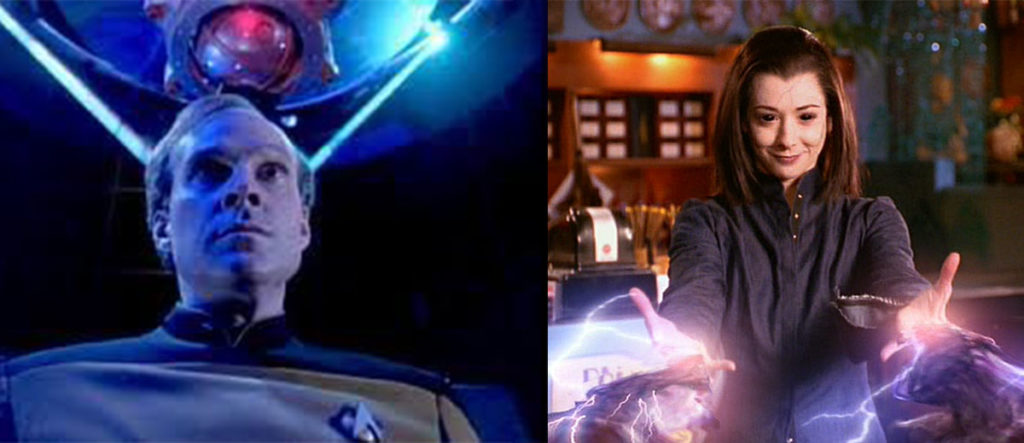
Barclay’s supercharged brain; Willow’s supercharged magic.
Premise: Mousey nerd turns supervillian
While Barclay’s run as a supergenius in “The Nth Degree” is short lived and Willow’s progression into a black magic wielding ultra-witch spans multiple episodes, their arcs are strikingly similar. Both Barclay and Willow (particularly in the first 4 seasons) are depicted as meek and shy, cast in their own minds as the “sidekick” to their more powerful peers. When each is suddenly imbued with a terrifying amount of power, their friends fear how far they will go. Ultimately both must cope with returning to their former, less powerful states, but with the knowledge of the terror they inflicted on the people they cared about.
9. TNG: The Next Phase (Season 5, Episode 24) vs. Buffy: Same Time, Same Place (Season 7, Episode 3)
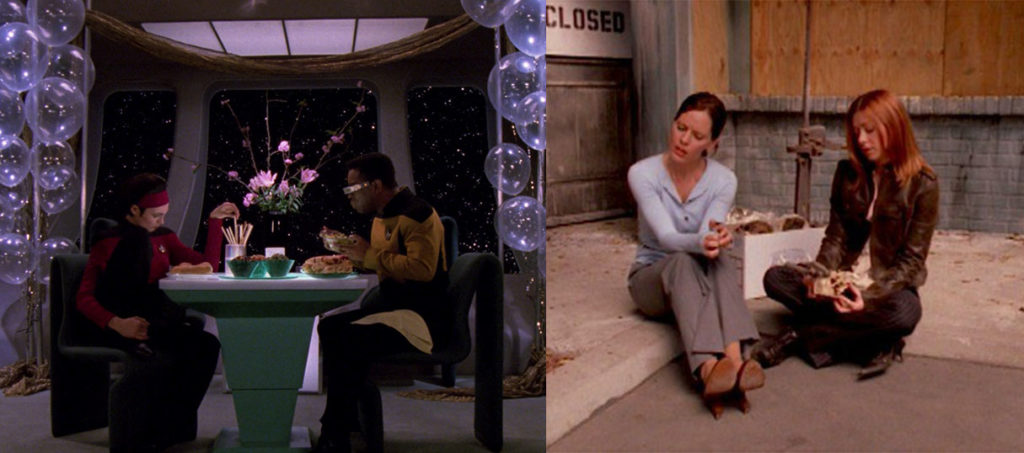
Ro and La Forge lament being dead; Willow laments being forgotten
Premise: When no one can see you
When LaForge and Ro end up out of phase with their timeline, they walk around witnessing normal life happening all around them, no one able to see or hear their cries for help. Following her stint in “magic rehab,” Willow returns to Sunnydale out of phase with everyone else around her. In this scenario, however, it’s not just that Willow’s friends don’t see her—she can’t see them either. While the mechanics may differ, the internal struggle is the same as each character grapples with what it’s like to be forgotten.
10. TNG: Tin Man (Season 3, Episode 20) vs.Buffy: Earshot (Season 3, Episode 18)
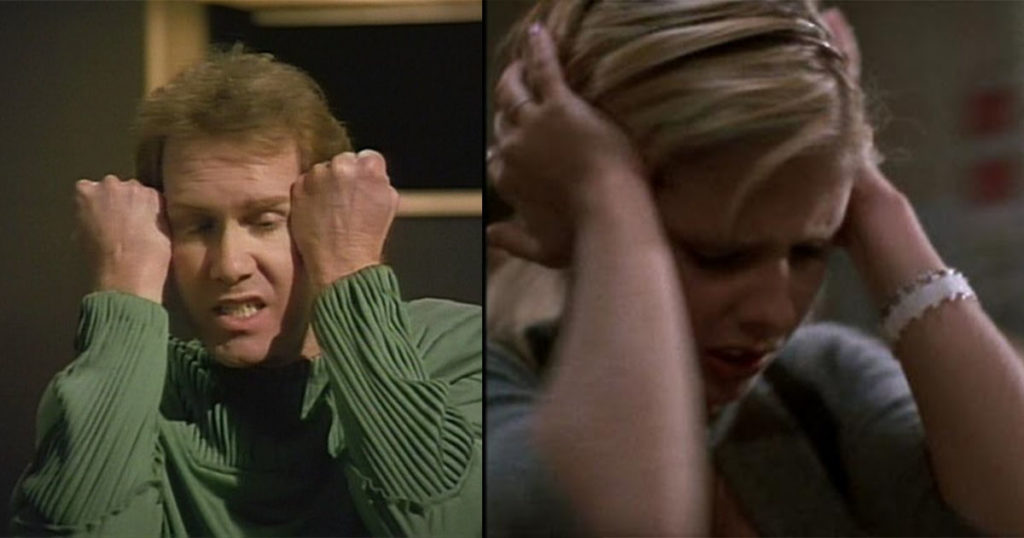
Tam wants the voices to stop, and so does Buffy
Premise: Telepathy isn’t all it’s cracked up to be
Admittedly one of the weaker comparisons, but similar nonetheless. Tam is a lifelong Betazoid telepath, while Buffy suddenly gains the ability after coming in contact with a demon. While Buffy’s telepathy isn’t permanent, it causes her to react the same as Tam, isolating herself to escape the pain caused by constant chatter in her head. Ultimately, Buffy recovers, but not before using her telepathy to prevent a classmate’s suicide. Tam, meanwhile, chooses suicide by joining with the Tin Man lifeform. Bonus points: While he doesn’t appear in “Earshot,” Harry Groener, who plays Tam, also played the Mayor of Sunnydale in this season of Buffy.
While this was a fascinating informing read, I disagree that Willow was that ”shy and meek” or ”a mousy nerd” by that point of the series, nor she was a mere sidekick once she began applying her computer skills and then developing into a powerful witch. Moreover, I don’t think the character saw herself that way past season 3-4 and that was more of a sarcastic remark and maybe also a meta-reference. Nor Willow was ”suddenly imbued with terrifying power” as we saw her playing with proverbial magic fire throughout first half of season 6. Plus, that’s not really why she became dark (grief corrupted her more than power did) and the premise was more of what grief can do to people and how to stop your best friend from losing herself completely (whilst saving the world from her in the process).
Very cool! I might be inspired to go back and rewatch Buffy after reading this.
I had totally forgotten that there was a TNG episode with two Rikers. It’s similar to the TOS episode “Enemy Within” where a transporter accident makes two Kirks. It’s interesting to see the connection made between Trek and Buffy.
Interesting. Joss Whedon’s got a bit of a history of claiming no knowledge of previous series. Yeah, yeah, we believe you, Joss. (See here for an argument that Firefly was more influenced by Blakes 7 than he claims: http://strangehorizons.com/non-fiction/articles/boucher-backbone-and-blake-the-legacy-of-blakes-7/#note1)
Joss Whedon wasn’t the only scenarist on Buffy… They were a lot.
In fact, none of them was written by Whedon. They were all written by his others (very talented) scenarists.
Whedon wrote and directed 27 episodes (in those 27, we can find every “cult episodes”, if I can say that), but everything else was written and directed by other people.
When he wasn’t writing or directing, he was supervizing everything, and had the power to validate, or change the stories.
Buffy sure is his baby, but the show wasn’t a “one man creation”. A lot of people contributed to this amazing story.